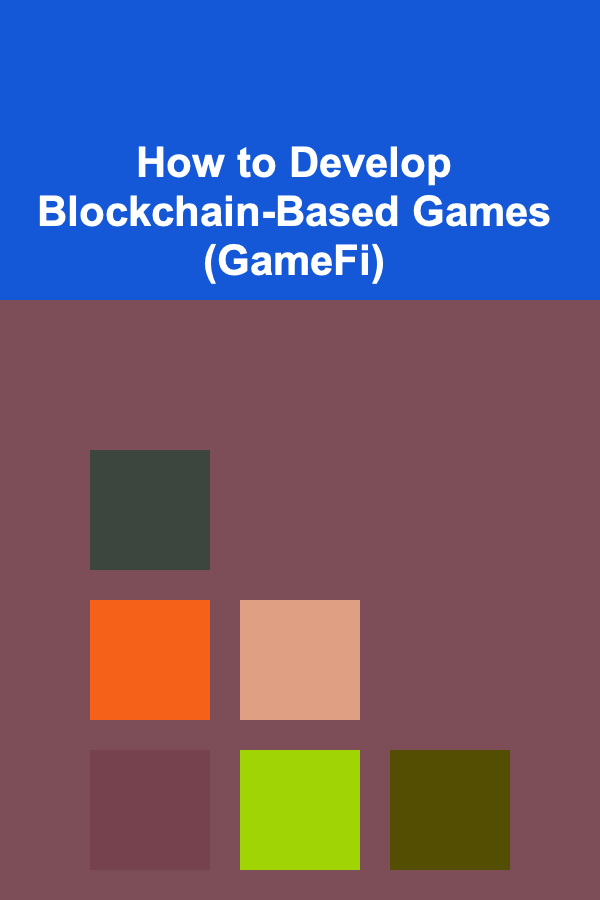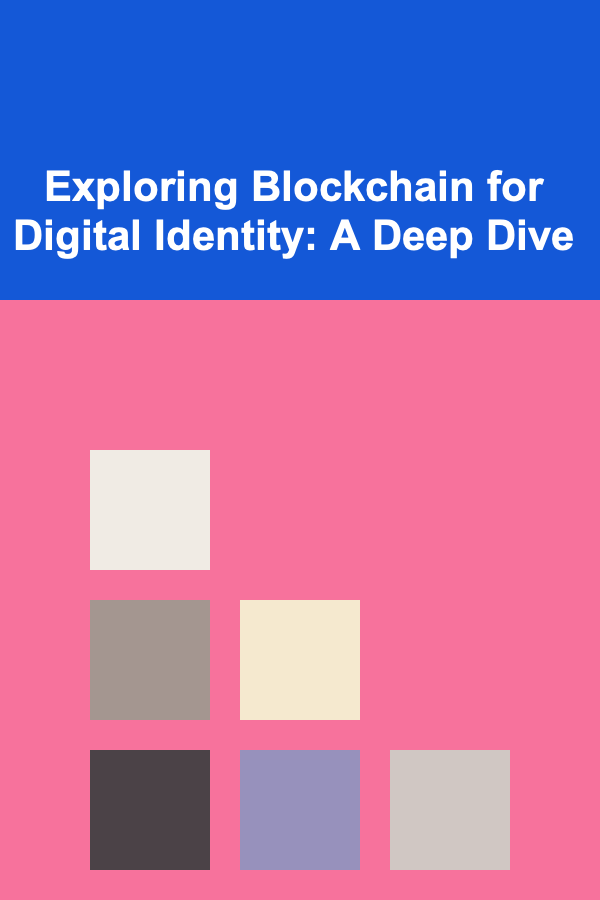
How to Develop Blockchain-Based Games (GameFi)
ebook include PDF & Audio bundle (Micro Guide)
$12.99$6.99
Limited Time Offer! Order within the next:

Blockchain technology, originally designed for cryptocurrencies like Bitcoin, has evolved into a powerful tool with applications in a wide range of industries. One such area where blockchain is making significant strides is in the world of gaming, particularly with the rise of GameFi --- games that integrate blockchain elements into their design. These games allow players to own, trade, and earn assets in the form of non-fungible tokens (NFTs) or cryptocurrencies, offering new ways to engage with digital worlds.
In this comprehensive guide, we will explore how to develop blockchain-based games, also known as GameFi. From understanding the core components of blockchain technology to building the game's infrastructure and integrating crypto-economic systems, we will delve into every aspect of creating a GameFi project.
Understanding Blockchain Technology for Games
Before jumping into the development of a blockchain-based game, it's crucial to understand the underlying technology. Blockchain is a decentralized, distributed ledger that records transactions across multiple computers. This ensures that the data is immutable and transparent. It eliminates the need for a central authority, making blockchain an ideal technology for creating decentralized applications (dApps) like GameFi.
Key Concepts in Blockchain
- Decentralization: Unlike traditional games, where the game server is controlled by a central authority (the game developer or publisher), blockchain-based games are decentralized. This means that players have more control over their assets and can engage in peer-to-peer transactions.
- Smart Contracts: Smart contracts are self-executing contracts with the terms of the agreement directly written into code. In the context of GameFi, smart contracts handle the creation, distribution, and transfer of in-game assets like NFTs and cryptocurrencies. These contracts operate on blockchain platforms such as Ethereum, Binance Smart Chain, or Solana.
- Non-Fungible Tokens (NFTs): NFTs represent unique digital assets. In GameFi, NFTs are often used to represent in-game items, characters, skins, and even virtual land. Unlike cryptocurrencies, which are interchangeable (fungible), NFTs are unique and can be bought, sold, or traded on various marketplaces.
- Cryptocurrencies: Many blockchain-based games use cryptocurrencies as an in-game currency. These tokens can be earned through gameplay, traded for real-world value, or used to purchase in-game items or assets. Some games have their own native tokens, while others use popular cryptocurrencies like Ethereum (ETH) or Binance Coin (BNB).
- Interoperability: Interoperability refers to the ability of different blockchain networks to communicate with each other. In GameFi, this can be particularly important when players wish to transfer their assets between different games or platforms. Interoperability ensures that assets like NFTs can be used across multiple games or virtual worlds.
Key Components of Blockchain-Based Games
Creating a blockchain-based game involves various technical and design components. Let's break down the key elements you need to consider when developing your GameFi project.
a. Game Design
The core gameplay mechanics should still be the foundation of your game, regardless of the blockchain integration. Traditional game design elements such as story, gameplay, art style, and mechanics must be thoughtfully crafted. The blockchain component should be an enhancement rather than the primary focus of the game.
- Play-to-Earn (P2E): One of the most prominent features of GameFi is the Play-to-Earn model, which allows players to earn cryptocurrency or NFTs through gameplay. The more a player participates in the game, the more rewards they receive, creating an incentivized system for engagement.
- Ownership of Assets: Blockchain enables players to truly own in-game assets. In traditional games, assets like skins, weapons, and characters are typically owned by the game developer. In GameFi, these assets are tokenized as NFTs, and players can buy, sell, or trade them freely on external marketplaces.
- Game Economy: The in-game economy in a GameFi project is more complex than in traditional games. Developers must create a system where the game's virtual assets (tokens, NFTs, etc.) have real-world value. This requires a well-designed economy to balance supply and demand, prevent inflation, and ensure long-term sustainability.
- Social and Community Aspects: Many blockchain-based games incorporate social elements such as guilds, tournaments, or player-owned virtual spaces. These aspects foster a sense of community, which is essential for the success of a GameFi project. Additionally, community governance models, where players can vote on key decisions, are becoming increasingly popular.
b. Blockchain Platform Selection
The blockchain platform you choose for your game will have a significant impact on the game's development and user experience. Some of the most popular platforms for developing GameFi projects include:
- Ethereum: Ethereum is the most widely used blockchain platform for decentralized applications. It supports smart contracts and NFTs, making it an ideal choice for GameFi. However, Ethereum's high gas fees and scalability issues can be a concern for developers and players.
- Binance Smart Chain (BSC): BSC is a more scalable and cost-effective alternative to Ethereum. With lower transaction fees and faster processing times, BSC is an attractive option for blockchain games that need high throughput.
- Solana: Known for its high-speed transactions and low fees, Solana is becoming a popular choice for blockchain game developers. Its unique consensus mechanism (Proof of History) allows for fast and secure transactions, making it suitable for real-time multiplayer games.
- Polygon: Polygon is a Layer-2 scaling solution for Ethereum that helps address the platform's scalability issues. It enables faster and cheaper transactions while maintaining Ethereum's security features, making it a great choice for GameFi projects looking for an Ethereum-compatible solution.
- Flow: Flow is a blockchain designed specifically for digital assets, including NFTs and gaming applications. It has been used by major projects like NBA Top Shot and provides a developer-friendly environment with high scalability and low fees.
c. Smart Contract Development
Smart contracts are the backbone of blockchain-based games, automating processes such as asset transfers, rewards distribution, and game logic. Developing smart contracts for a GameFi project involves:
- Token Creation: You'll need to create custom tokens (fungible or non-fungible) to represent in-game assets, rewards, or currency. These tokens can be ERC-20 (for fungible tokens) or ERC-721/ERC-1155 (for NFTs) if you are developing on Ethereum or compatible chains.
- Game Mechanics and Logic: Smart contracts govern many aspects of the game's mechanics. For example, a smart contract might determine how rewards are distributed to players based on their actions, or how in-game purchases are processed.
- Security: Smart contracts are immutable, meaning once they're deployed, they cannot be changed. This highlights the importance of thorough testing and security audits to ensure that the contract functions as intended and is free of vulnerabilities. Blockchain games are frequent targets for hackers, so it's essential to prioritize security.
- Gas Fees Optimization: Gas fees are the transaction fees paid to miners for executing operations on the blockchain. Optimizing smart contracts to reduce the cost of transactions is crucial, especially for games with frequent player interactions.
d. Front-End Development
While blockchain handles the back-end infrastructure, the front-end is responsible for providing players with an engaging user interface (UI) and user experience (UX). GameFi games need to be visually appealing and easy to navigate while interacting with blockchain elements.
- Wallet Integration: Players need a way to interact with the blockchain, which is typically done through cryptocurrency wallets. The most common wallet options include MetaMask, Trust Wallet, and Coinbase Wallet. Integrating these wallets into your game will allow players to connect their wallets, purchase assets, and earn rewards directly within the game.
- User Interface (UI) Design: The UI should be intuitive, allowing players to easily understand and interact with the blockchain features, such as managing NFTs and tokens, viewing transaction histories, and participating in staking or governance.
- Multiplatform Support: GameFi projects often support cross-platform gameplay. This means your game should be accessible on various devices, including PC, mobile, and potentially VR or AR platforms. Ensuring a seamless experience across different platforms is crucial to attracting a wide player base.
e. NFTs and Asset Marketplace
A core feature of blockchain-based games is the ability to create, buy, sell, and trade NFTs. These digital assets can represent in-game items, skins, characters, or even virtual real estate. To develop the NFT marketplace for your GameFi project:
- Create a Marketplace: Your game should have an integrated marketplace where players can list their NFTs for sale, purchase other players' assets, or bid on rare items. This could either be a custom-built marketplace or integration with existing platforms like OpenSea or Rarible.
- Liquidity and Rarity: Managing the rarity and value of NFTs within the game is essential to maintain a healthy marketplace. Developers should control how assets are distributed and introduce scarcity to make certain items more valuable.
- Ownership and Transfer: Blockchain technology ensures that players truly own their assets, and this ownership can be easily transferred or sold. Smart contracts can handle the transfer of NFTs from one player to another, ensuring that each transaction is secure and transparent.
f. Tokenomics and Economic Model
A sustainable economic model is crucial for any GameFi project. Tokenomics refers to the structure of the game's economy, which includes how in-game currencies and NFTs are created, distributed, and exchanged. Some of the key aspects of tokenomics include:
- Inflation and Deflation: GameFi developers must carefully balance the issuance of tokens and assets to prevent inflation. If too many tokens are issued without proper demand, it can lead to a decrease in value. Conversely, introducing mechanisms for deflation, such as burning tokens, can help maintain scarcity.
- Staking and Yield Farming: Many GameFi projects incorporate staking and yield farming mechanisms, where players can stake their tokens to earn rewards. This creates incentives for players to hold their tokens rather than selling them immediately, helping stabilize the game's economy.
- Governance and Community Involvement: Some GameFi projects implement decentralized governance, allowing players to vote on key decisions such as updates to the game, tokenomics changes, and community-driven initiatives. This strengthens the bond between the game and its players, making them more invested in the long-term success of the project.
Marketing and Community Engagement
Once the game is developed, the next challenge is attracting and retaining players. Building a community around your GameFi project is crucial to its success. Here are some strategies to promote your blockchain-based game:
- Partnerships: Partnering with influencers, other blockchain projects, and gaming communities can help spread the word about your game. Partnerships with popular NFT artists or other gaming platforms can also provide valuable exposure.
- Airdrops and Initial Coin Offerings (ICOs): Offering airdrops (free tokens) or ICOs can help generate interest in your game before its official release. These strategies can create a sense of urgency and excitement around the launch.
- Social Media and Community Building: Use platforms like Twitter, Discord, Reddit, and Telegram to build a community. Regular updates, interactive AMA (Ask Me Anything) sessions, and community contests can help keep players engaged and invested.
- Incentives: Offering rewards for players who refer others to the game, complete milestones, or participate in community events can help foster loyalty and increase the player base.
Conclusion
Developing a blockchain-based game (GameFi) is a complex but highly rewarding process. By integrating blockchain technology with engaging gameplay mechanics, you can create a game that offers players real ownership of their assets, opportunities to earn rewards, and a decentralized gaming experience. However, to succeed in the GameFi space, developers need to carefully design the game's economy, choose the right blockchain platform, and create a robust tokenomics structure. By following the guidelines outlined in this article and staying attuned to the evolving landscape of blockchain gaming, you can create a successful and sustainable GameFi project that resonates with players and investors alike.

How to Create a Cozy Outdoor Living Space During Renovation
Read More
How to Create a Simple and Scalable Business Operations Plan
Read More
How to Reflect on Your Wedding Planning Experience for Future Events
Read More
How to Utilize Overhead Storage Solutions in Your Garage
Read More
How To Draw Fantasy Maps and Worlds
Read More
Exploring Blockchain for Digital Identity: A Deep Dive
Read MoreOther Products

How to Create a Cozy Outdoor Living Space During Renovation
Read More
How to Create a Simple and Scalable Business Operations Plan
Read More
How to Reflect on Your Wedding Planning Experience for Future Events
Read More
How to Utilize Overhead Storage Solutions in Your Garage
Read More
How To Draw Fantasy Maps and Worlds
Read More